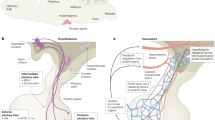Abstract
Purpose
The aim of this study was to generate immortalized human anterior pituitary adenoma cells. Reliable cell models for the study of human pituitary adenomas are as yet lacking and studies performed so far used repeated passaging of freshly excised adenomas, with the attendant limitations due to limited survival in culture, early senescence, and poor reproducibility.
Methods & Results
We devised a technique based upon repeated co-transfections of two retroviral vectors, one carrying the catalytic subunit of human telomerase, hTERT, the other SV40 large T antigen. This approach extended the lifespan of cells derived from a human growth hormone-secreting adenoma up to 18 months while retaining morphology of primary cells, growth hormone synthesis and growth hormone secretion.
Conclusions
Our attempt represents the first demonstration of successful lifespan extension of human growth hormone-secreting pituitary adenoma cells via co-transfection of hTERT and SV40T and paves the way to future attempts to obtain stable cell lines.


Similar content being viewed by others
References
K. Inoue, M. Hattori, T. Sakai et al., Establishment of a series of pituitary clonal cell lines differing in morphology, hormone secretion, and response to estrogen. Endocrinology 126, 2313–2320 (1990)
M.J. Reymond, D.D. Nansel, G.H. Burrows, W.B. Neaves, J.C. Porter, A new clonal strain of rat pituitary tumour cells: a model for non-regulated secretion of prolactin. Acta Endocrinol. 106, 459–470 (1984)
J. Furth, E.L. Gadsen, A.C. Upton, ACTH secreting transplantable pituitary tumors. Proc. Soc. Exp. Biol. Med. 84, 253–254 (1953)
D. Lew, H. Brady, K. Klausing et al., GHF-1-promoter-targeted immortalization of a somatotropic progenitor cell results in dwarfism in transgenic mice. Genes. Dev. 7, 683–693 (1993)
E.T. Alarid, J.J. Windle, D.B. Whyte, P.L. Mellon, Immortalization of pituitary cells at discrete stages of development by directed oncogenesis in transgenic mice. Development 122, 3319–3329 (1996)
Y. Kokubu, M. Asashima, A. Kurisaki, Establishment and culture optimization of a new type of pituitary immortalized cell line. Biochem. Biophys. Res. Commun. 463, 1218–1224 (2015)
G.L. Kim, X. Wang, J.A. Chalmers et al., Generation of immortal cell lines from the adult pituitary: role of cAMP on differentiation of SOX2-expressing progenitor cells to mature gonadotropes. PloS. ONE. 6, e27799 (2011)
D. Avtanski, H.J. Novaira, S. Wu et al., Both estrogen receptor alpha and beta stimulate pituitary GH gene expression. Mol. Endocrinol. 28, 40–52 (2014)
J.C. Stone, J. Clark, R. Cuneo, A.W. Russell, S.A. Doi, Estrogen and selective estrogen receptor modulators (SERMs) for the treatment of acromegaly: a meta-analysis of published observational studies. Pituitary 17, 284–295 (2014)
A.P. Heaney, F. Manory, W.H. Hong, S. Melmed, Functional PPAR-gamma receptor is a novel therapeutic target for ACTH-secreting pituitary adenomas. Nature. Med. 8, 1281–1287 (2002)
F. Pecori Giraldi, C. Scaroni, E. Arvat et al., Effect of protracted treatment with rosiglitazone, a PPARgamma agonist, in patients with Cushing’s disease. Clin. Endocrinol. 64, 219–224 (2006)
F. Pecori Giraldi, S. Pesce, P. Maroni et al., Inhibitory effect of preproTRH(178-199) on ACTH secretion by human corticotrope tumours. J. Neuroendocrinol. 22, 294–300 (2010)
S. Nanni, V. Benvenuti, A. Grasselli et al., Endothelial NOS, estrogen receptor beta, and HIFs cooperate in the activation of a prognostic transcriptional pattern in aggressive human prostate cancer. J. Clin. Invest. 119, 1093–1108 (2009)
A.H. Tashjian Jr., Y. Yasumura, L. Levine, G.H. Sato, M.L. Parker, Establishment of clonal strains of rat pituitary tumor cells that secrete growth hormone. Endocrinology 82, 342–352 (1968)
P. Thomas, P.L. Mellon, J. Turgeon, D.W. Waring, The L beta T2 clonal gonadotrope: a model for single cell studies of endocrine cell secretion. Endocrinology 137, 2979–2989 (1996)
D. Sizova, Y. Ho, N.E. Cooke, S.A. Liebhaber, T-antigen transformation of pituitary cells captures three novel cell lines in the Pit-1 lineage. Mol. Endocrinol. 24, 2232–2240 (2010)
J. Ham, J. Webster, J.A. Bond et al., Immortalized human pituitary cells express glycoprotein alpha-subunit and thyrotropin beta (TSH beta). J. Clin. Endocrinol. Metab. 83, 1598–1603 (1998)
P. Chomczynski, P.A. Soszynski, L.A. Frohman, Stimulatory effect of thyroid hormone on growth hormone gene expression in a human pituitary cell line. J. Clin. Endocrinol. Metab. 77, 281–285 (1993)
J.H. Wyche, W.D. Noteboom, Growth regulation of cultured human pituitary cells by steroidal and nonsteroidal compounds in defined medium. Endocrinology 104, 1765–1773 (1979)
Y. Kikuchi, K. Seki, E. Momose et al., Establishment and characterization of a new human cultured cell line from a prolactin-secreting pituitary adenoma. Cancer Res. 45, 5722–5727 (1985)
D.C. Danila, X. Zhang, Y. Zhou et al., A human pituitary tumor-derived folliculostellate cell line. J. Clin. Endocrinol. Metab. 85, 1180–1187 (2000)
L. Jin, E. Kulig, X. Qian et al., A human pituitary adenoma cell line prolfierates and maintains some differentiated fucntions following expression of SV40 large T-antigen. Endocr. Pathol. 9, 169–184 (1998)
M.B.S. Lopes, Growth hormone-secreting adenomas: pathology and cell biology. Neurosurg. Focus. 29, E2–E8 (2010)
Acknowledgements
This work was supported by the Italian Ministry of Education, University and Research (PRIN2010TYCL9B_006) to AF, (PRIN2010TYCL9B_004) to FPG, (PRIN2010TYCL9B-001) and PRIN 2015 (PRIN2015ZHKFTA) to SC; and by the Italian Ministry of Health (GR 2011-02351557) to SN and (RF-2013-02356201) to SC.
Author information
Authors and Affiliations
Corresponding author
Ethics declarations
Conflict of interest
The authors declare that they have no competing interests.
Ethical approval
All procedures performed in studies involving human participants were in accordance with the ethical standards of the institutional and/or national research committee and with the 1964 Helsinki declaration and its later amendments or comparable ethical standards.
Informed consent
Informed consent was obtained from all individual participants included in the study.
Additional information
Aurora Aiello, Maria Francesca Cassarino and Simona Nanni contributed equally to this work.
Rights and permissions
About this article
Cite this article
Aiello, A., Cassarino, M.F., Nanni, S. et al. Establishment of a protocol to extend the lifespan of human hormone-secreting pituitary adenoma cells. Endocrine 59, 102–108 (2018). https://doi.org/10.1007/s12020-017-1305-6
Received:
Accepted:
Published:
Issue Date:
DOI: https://doi.org/10.1007/s12020-017-1305-6




